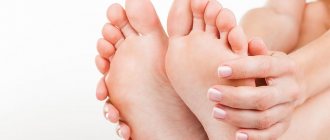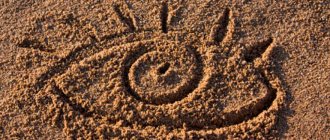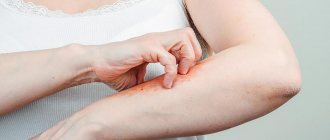Nail diseases in children are rare; more often the cause of the disorder is damage to the nail plate or the skin around it. All mothers know how much a child “loves” to eat, pick his nails, and pull off hangnails. Pathological changes cause both diseases or injuries of the nail plate and the skin around it, as well as problems with the health of internal organs.
Color change
Normally, a child’s nails are a soft pink color with a pronounced whitish hole at the base. What factors change their color? What might a certain color indicate?
White
Sometimes white spots appear on the child's fingernails or toenails. This condition is medically called leukonychia.
There are several forms of it:
- total, the entire nail plate becomes white;
- stripe-like, transverse white stripes are formed;
- dotted, white dots appear on the child’s nails;
- limited, manifests itself in the form of elongated spots of small size.
People believe that white spots occur due to excessive intake of vitamins and minerals, but in fact this is not the case. The causes of white spots on a child’s nails are long-term minor injuries, mechanical damage to the growth zone, and the habit of biting nails. Such changes may appear on your feet due to improperly selected shoes. White spots on a child's nails may be a manifestation of a fungal infection (onychomycosis).
Among systemic diseases, leukonychia is caused by iron deficiency anemia, pathologies of the liver, heart, intoxication, impaired protein digestion, psoriasis, and eczema.
The white spots and stripes on a child’s nails themselves do not require treatment.
In most cases, this is a temporary cosmetic defect that disappears as the nail plate grows. If they appear again, you need to consult a doctor, undergo an examination, and find out their cause.
Yellow
Yellow color is almost always a sign of onychomycosis. This disease is much less common in children than in adults. But it cannot be ruled out. Another yellow color is characteristic of psoriasis.
In addition, the yellow color of a child’s nails is provoked by abnormalities in the liver with impaired bilirubin metabolism, jaundice, pathologies of the endocrine and lymphatic systems, and chronic inflammation of the mucous membrane of the paranasal sinuses.
Red
The red coloration of a child's nails is associated with inflammatory processes in the soft tissues of the nail bed, impaired blood flow in the capillaries, and dilation of small vessels. It is often observed with high temperature and fever.
Red or brown stripes or dashes are the consequences of damage to small vessels under the nail plate that occur as a result of injury.
Black
One of the common causes of black color is household injuries. For example, if a child pinches a finger with a nail in an interior or entrance door. After a severe bruise, swelling occurs, hemorrhage into the soft tissues of the nail bed, and a hematoma forms. After 10 hours, the child's nail turns black or blue, depending on the severity of the injury.
To help your baby, immediately after an injury, apply a cold compress to the sore spot or place the injured finger under a stream of cold water from the tap.
The resulting hematoma resolves within 4 to 6 weeks.
Folk remedies
Some recipes are actively used as adjuvant therapy. Those that help disinfect the nail and strengthen it are used.
Best suited for these purposes:
- Salt compositions for hands and feet. To prepare them, you need to take five liters of water, dissolve two large spoons of sea salt in them, heat the resulting solution to a temperature of 38 degrees and immerse your hands or feet in it (note that separate baths must be prepared for hands and feet). You can add decoctions of chamomile, sage, string or oak bark to the water, the therapeutic effect will increase. In this way, you can simultaneously strengthen the nail plates and disinfect them, relieve inflammation and stimulate regeneration processes. To prepare a herbal decoction, you need to take two tablespoons of raw materials, brew them with a glass of boiling water, bring the resulting solution to a boil, and then filter through several layers of gauze before use.
- Garlic and salt lotions. They are prepared as follows: a tablespoon of salt is dissolved in a liter of water, a clove of garlic is grated on a fine grater, the juice is squeezed out of the resulting slurry, and it is poured into the saline solution. Before going to bed, the finished product is rubbed into the exfoliated plates using a cotton swab and left overnight. The procedure is resumed the next day, and so on until complete recovery. The specified proportions must not be changed under any circumstances. Children's skin is very sensitive, concentrated solutions can corrode it, so it is important to prepare traditional medicine strictly according to the recipe.
- Oils for strengthening nails. To strengthen the stratum corneum, apricot, peach, almond oil, as well as flaxseed and olive oil are best suited. Any of them should be applied to the peeling nail, and then gently rubbed into it with your fingers for thirty seconds. If you add an oil solution of vitamins E and A to a small amount, the therapeutic effect will increase significantly.
Change of structure
The surface of the nail plate is normally flat and smooth to the touch.
But under certain physiological or pathological conditions, relief stripes, pinpoint depressions, bulges, and grooves appear on it. Why does this happen, and what violations does it indicate?
Point depressions
Dotted depressions on the nail plate look as if its surface was poked with a needle. These multiple pits are called thimble syndrome. They are a characteristic sign of psoriasis. Also, pinpoint depressions can be associated with skin diseases (eczema, dermatosis, infections), alopecia areata (hair loss).
In infants, pinpoint dents on the nail plate are considered a physiological norm; as the baby grows older, they disappear on their own.
Transverse grooves
Transverse relief stripes on a child’s nails are called Bo’s lines. They are lines up to 1 mm deep, not different in color from a healthy nail plate. They are formed due to damage to the nail matrix (the place where the nail is formed). Their cause may be a lack of nutrients, metabolic disorders, mechanical injuries, impacts in the area of the hole, or taking certain medications. In children, Beau's lines appear after a high fever.
In infants, Bo lines are considered the physiological norm. They appear between 4 and 14 weeks of age and then disappear as the nail plate grows.
Their formation is associated with physiological changes and restructuring in the child’s body during childbirth.
Longitudinal grooves
Longitudinal or vertical stripes on a child’s nails are usually not dangerous. They look like parallel grooves running from the cuticle to the end of the free edge of the nail plate. Upon closer examination at close range in good lighting, you can see that every person has them.
If the longitudinal stripes are strongly pronounced, then this indicates a lack of B vitamins, zinc, iron, magnesium, and mechanical damage to the nail matrix.
If vertical stripes are combined with discoloration, loss of shine, brittleness and deformation of the child's nail, you should consult a doctor. This may signal chronic diseases of the respiratory tract, peripheral blood vessels, psoriasis, iron deficiency anemia, and lichen planus.
How is the diagnosis done?
The lesion may affect just one finger, several fingers, or all of them at once. This symptom is important for diagnosis, as it suggests the cause of dystrophy. If only one finger is injured, then most likely it is due to injury. If there are several, there are systemic violations.
The diagnosis is made by a dermatologist or podologist. First, inspects the problem area. Then, to find out the cause, he clarifies: whether the person has suffered viral infections over the past two months, what medications he took, whether there were any injuries, whether there are skin diseases. If necessary, prescribe a study of scraping the plate for fungus, a blood test for viral infections, autoimmune, systemic, and inflammatory diseases.
Delamination
Quite often, parents are faced with the fact that their child’s nails peel and break. Why is this happening?
This deviation causes:
- improper cutting of nails;
- lack of microelements, vitamins (vitamin A, E, B2, calcium, phosphorus, magnesium, zinc);
- mechanical damage. For example, nails on the hands peel if the child bites them or sucks fingers, on the feet - if he wears shoes that rub or squeeze the tips of the toes;
- health problems (iron deficiency anemia, adrenal dysfunction, onychomycosis).
In most cases, correction of nutrition, taking vitamin-mineral complexes, and rubbing vegetable oils rich in vitamins A and E into the nail plate helps to cope with delamination.
But if its cause is health problems, examination and tests will be needed.
Prevention of split nails in children
There are a number of rules, the observance of which helps prevent the development of the described disease. Experts recommend that parents:
- Treat any nail injuries in a timely manner, treat any damage immediately with iodine or brilliant green, or any other alcohol solution.
- Monitor your baby’s diet and include foods rich in zinc, iron, potassium, calcium, phosphorus and vitamins. There are many of them in fish and cottage cheese, in beef liver, in raw vegetables and fruits. Periodically, after consulting with your pediatrician, give your child synthetic multivitamin complexes.
- Constantly strengthen your immune system (walk more in the fresh air, play outdoor games, do hardening).
- Provide separate scissors for cutting your child’s nails and carefully monitor their cleanliness.
When the first signs of detachment appear, seek medical help immediately. In the early stages, the disease is successfully treated with conservative methods.
Nail plate separation
It is not uncommon for a child’s fingernails or toenails to peel off. Such an unpleasant picture frightens parents, because they do not understand what this is connected with.
Separation of the nail from the bed is called onycholysis. Its cause in 60% of cases is injury. If the baby hits, bruises, or presses the upper phalanx of the finger, the nutrition of the nail and adhesion to the nail bed are disrupted. Voids are formed, over which the nail becomes opaque and yellow.
In young children, nails can peel off even due to minor trauma, because their nail plates are very thin and soft.
In the event of an accidental injury, the child’s nails peel off only on the injured finger. If they come off on all fingers, then the reason is most likely that the baby is gnawing on them. This bad habit often causes parents to feel as if their child’s nails are not growing.
If this problem bothers you, keep an eye on your baby. Explain to him that this cannot be done. You may need the help of a psychologist to get rid of it.
Other factors that cause children's nails to peel include:
- fungal infection;
- contact of the nail plate with aggressive chemicals and household chemicals;
- purulent inflammation of the periungual folds;
- recent infectious diseases (enteroviral infection);
- disturbance of blood supply and nutrition of the extremities;
- systemic diseases (hyperkeratosis, psoriasis, eczema);
- taking certain medications.
If a child’s nail comes off as a result of injury, then after the damaged nail plate is peeled off, a new healthy nail will soon grow. The main thing is to ensure that no infection occurs during this period.
If redness or inflammation occurs, you should consult a doctor.
What to do if your child’s nails are peeling
Without eliminating the cause, treatment for nail separation will be useless. Therefore, when drawing up a therapeutic regimen, each specific case develops its own tactics.
For example, if a child constantly bites his nails, parents are advised to try using special varnishes (“Belweder Bitter Lacquer”, “Nekusayka”). Their coating has a persistent bitter taste, it helps to quickly wean the baby from a bad habit. If this treatment does not help, you need to contact a child psychologist.











